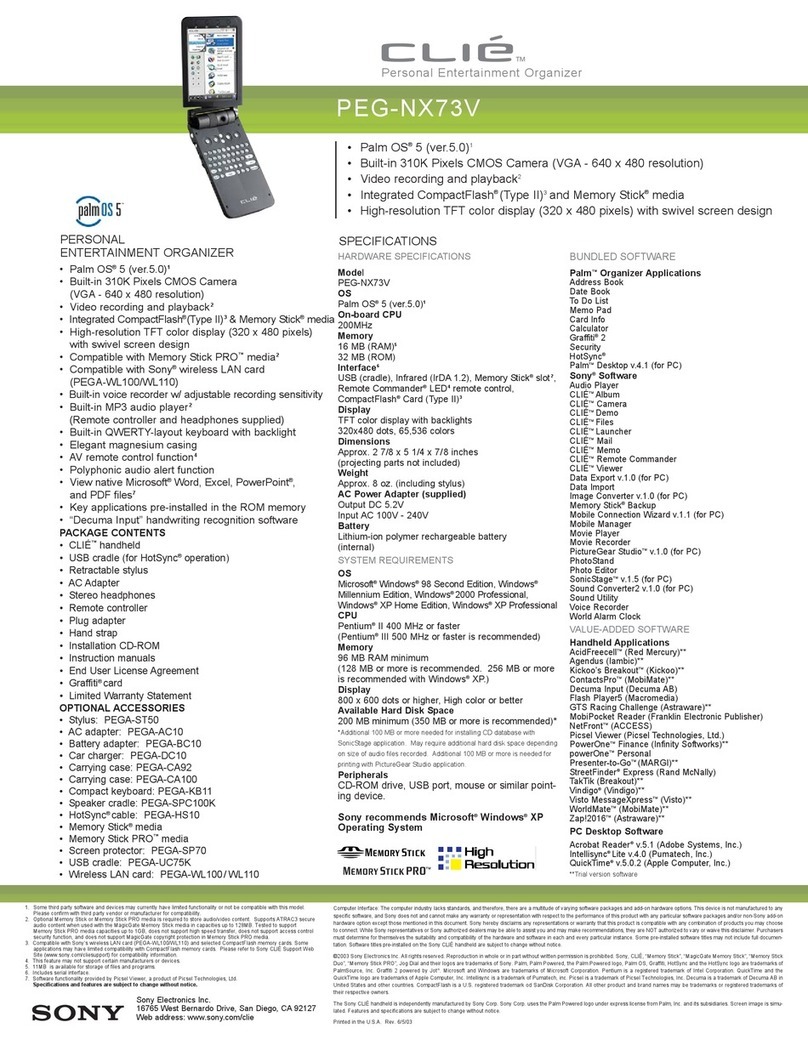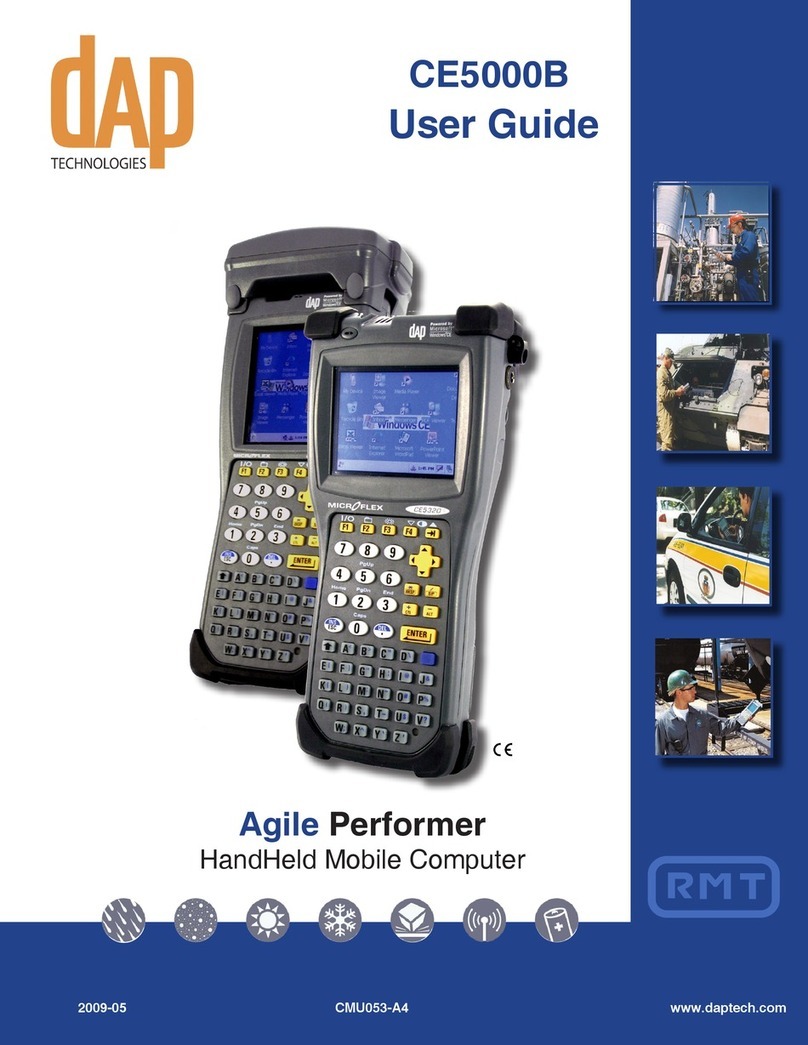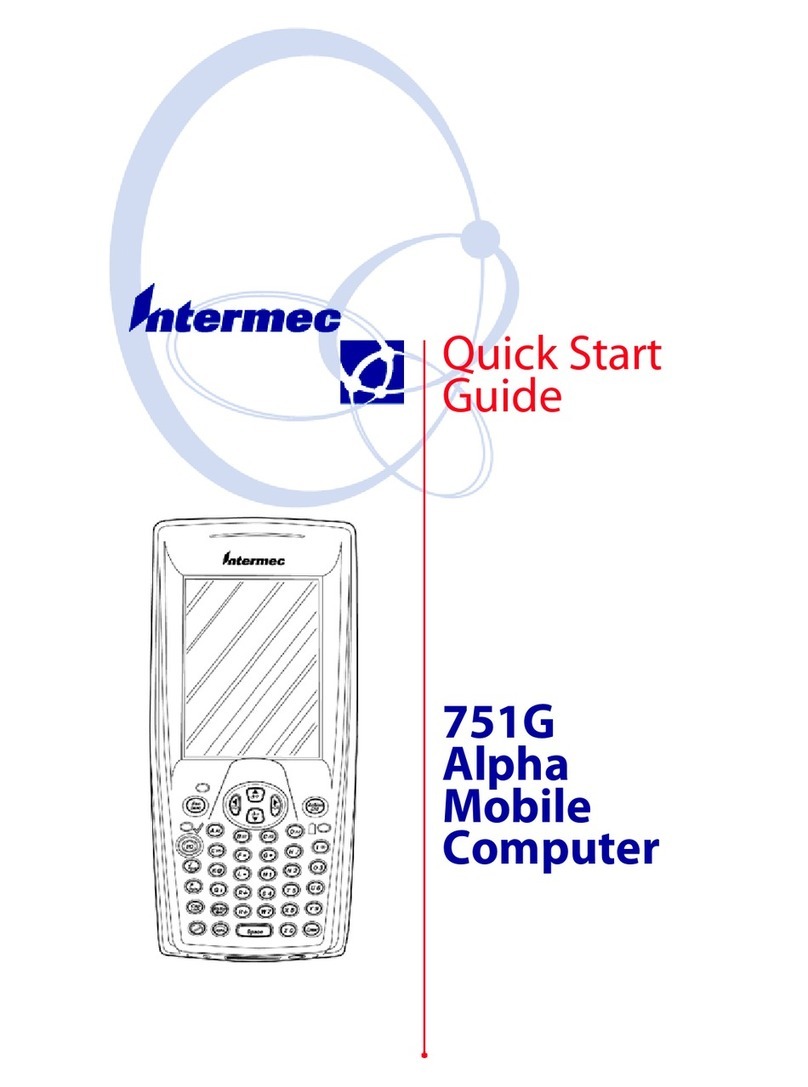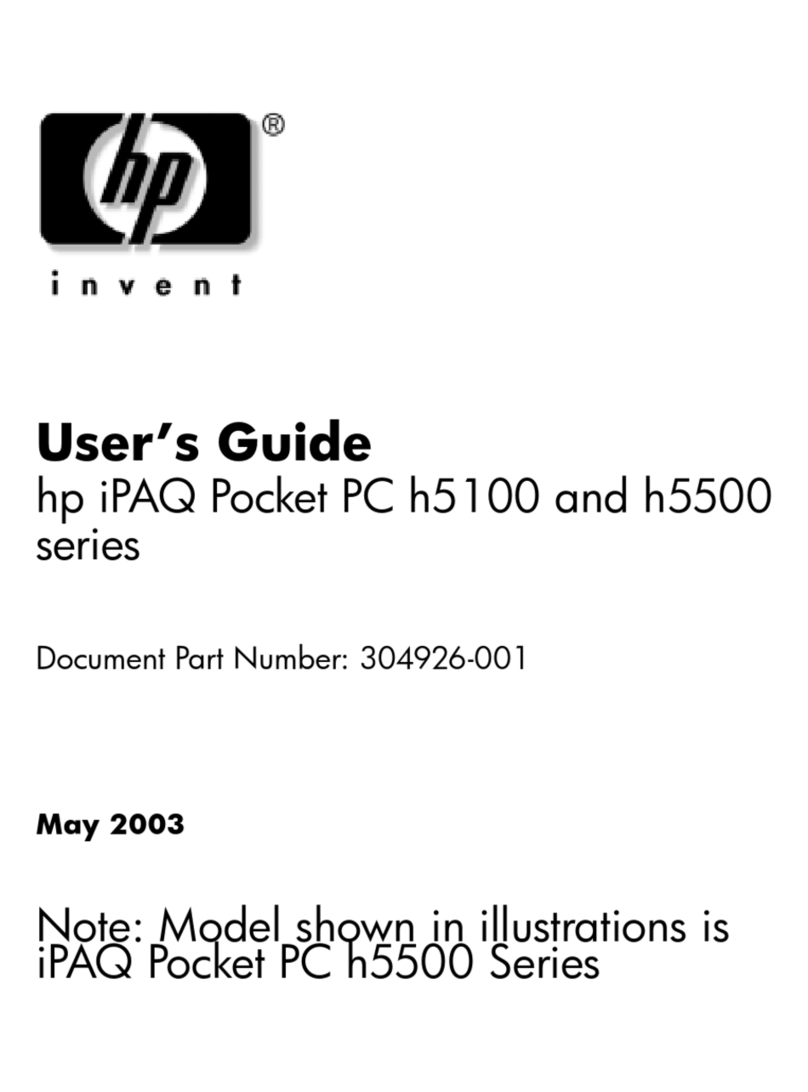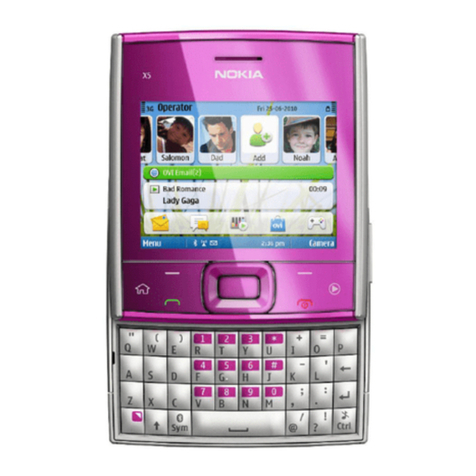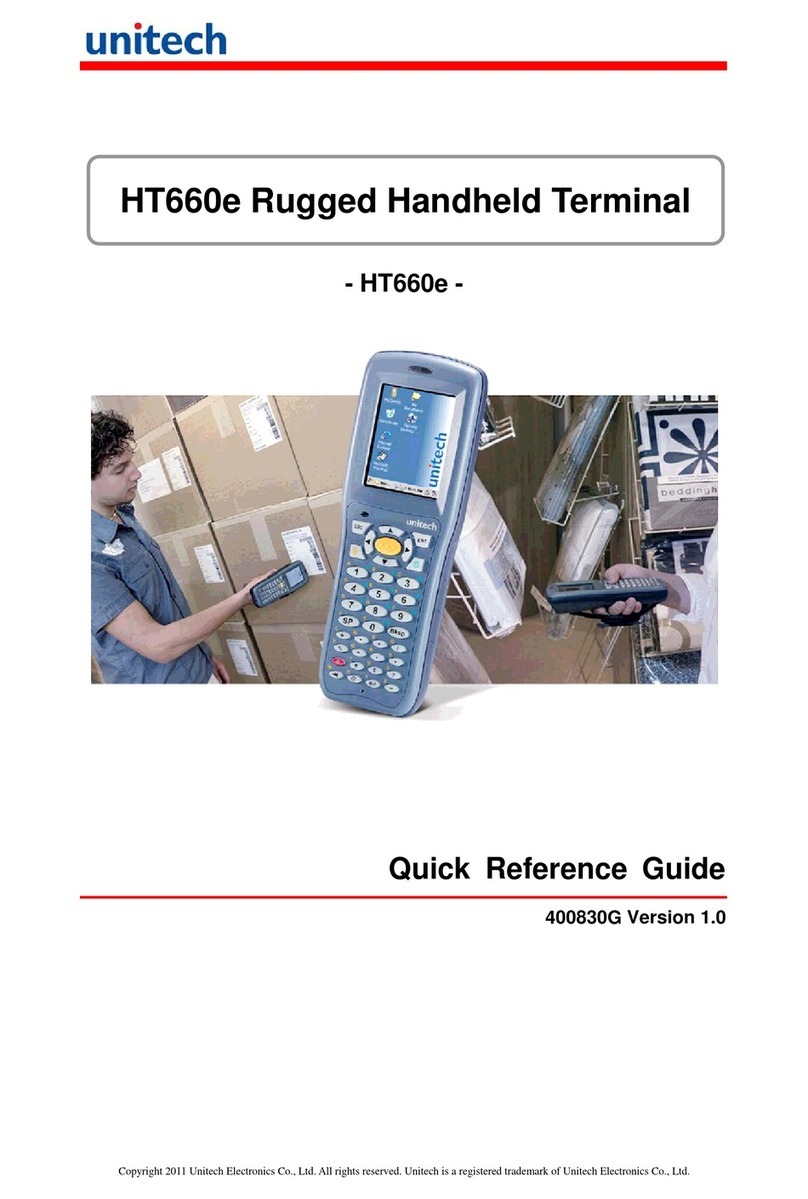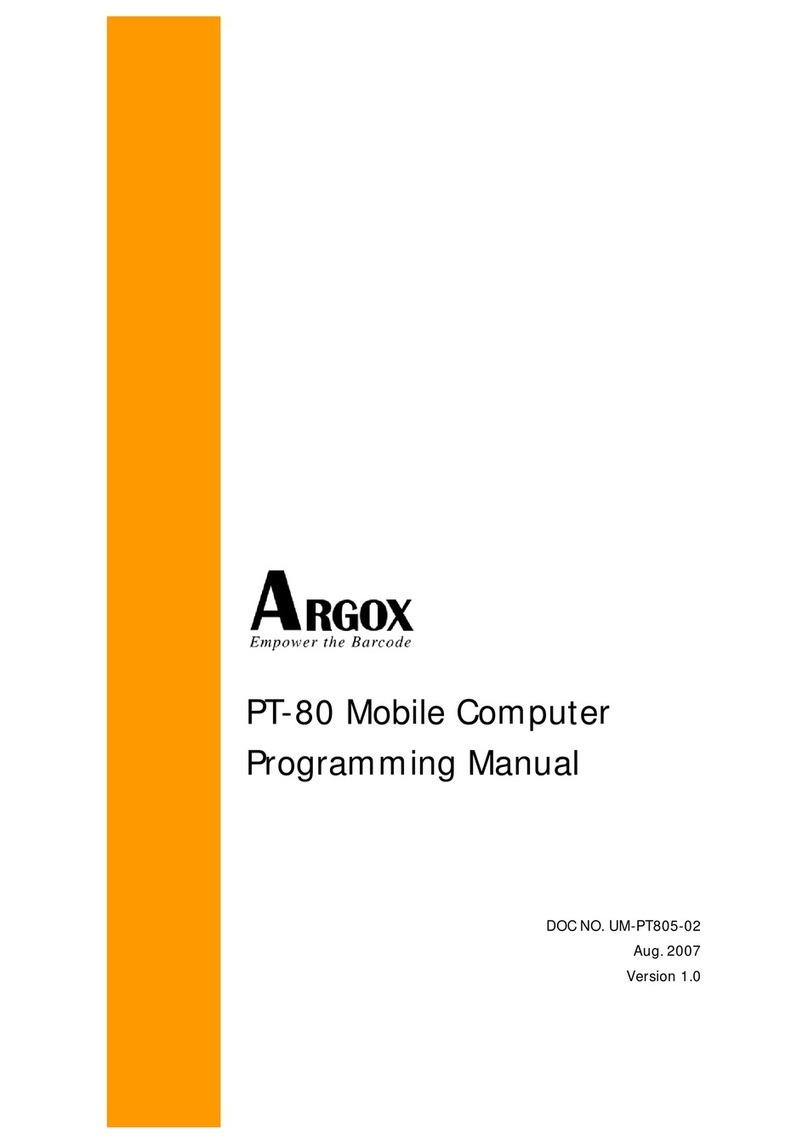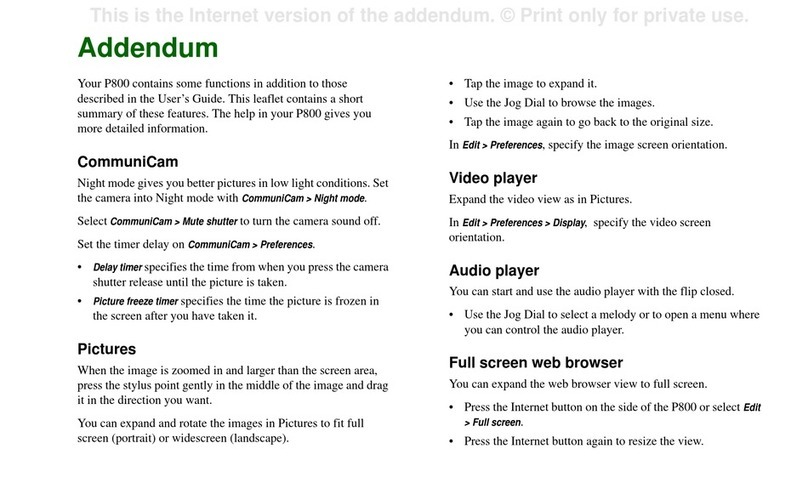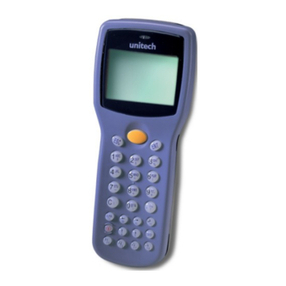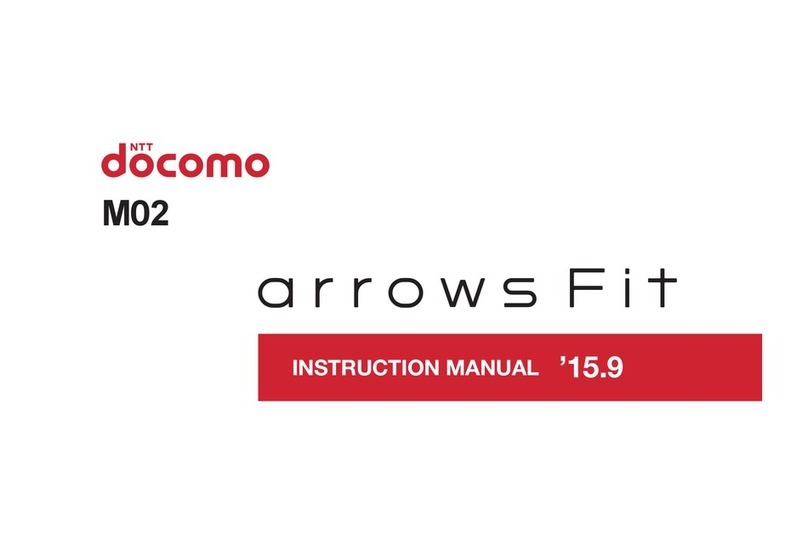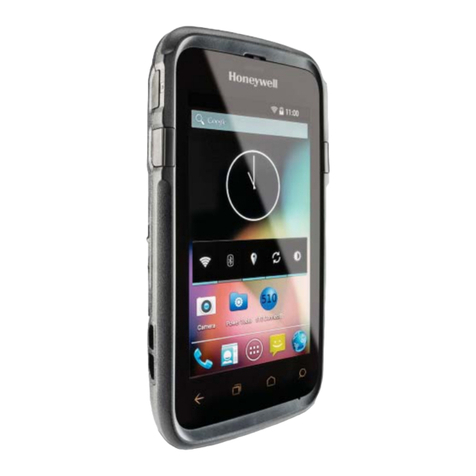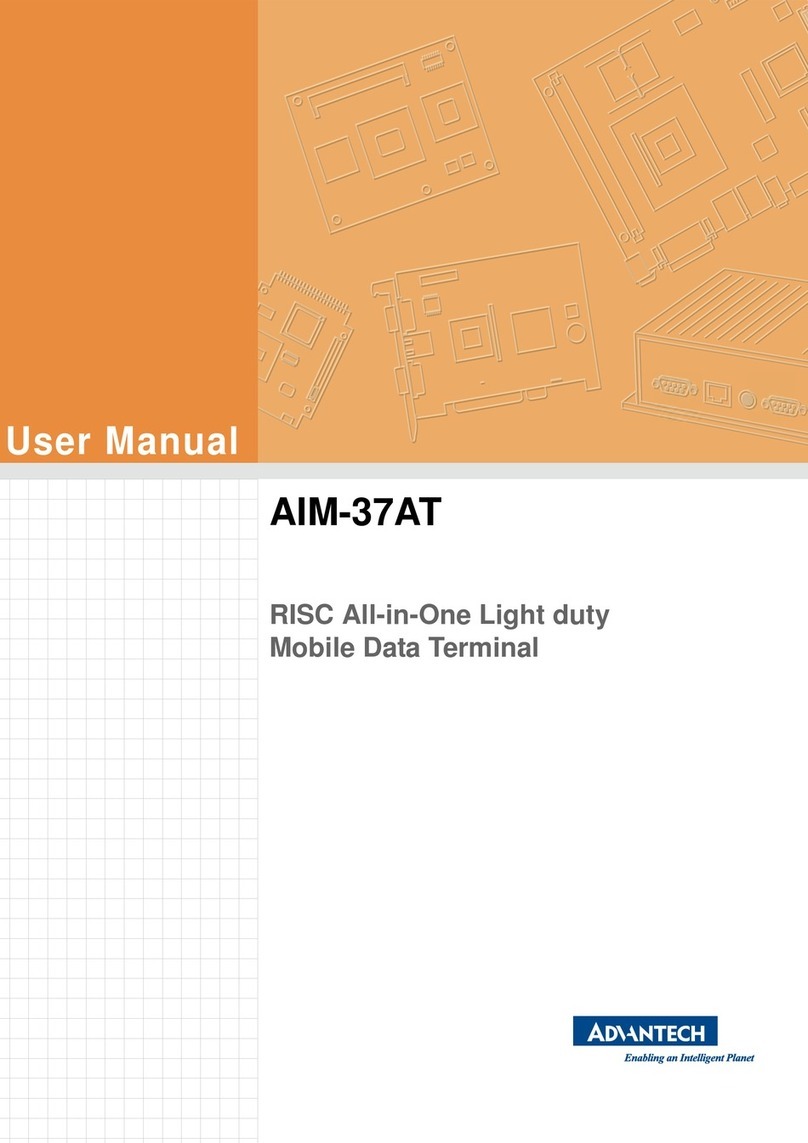ChipherLab 8400 User manual

8400 Series Mobile Compute
r
8400/8470
Version 1.03

Copyright © 2009~2010 CIPHERLAB CO., LTD.
All rights reserved
The software contains proprietary information of CIPHERLAB CO., LTD.; it is provided
under a license agreement containing restrictions on use and disclosure and is also
protected by copyright law. Reverse engineering of the software is prohibited.
Due to continued product development this information may change without notice. The
information and intellectual property contained herein is confidential between CIPHERLAB
and the client and remains the exclusive property of CIPHERLAB CO., LTD. If you find
any problems in the documentation, please report them to us in writing. CIPHERLAB
does not warrant that this document is error-free.
No part of this publication may be reproduced, stored in a retrieval system, or
transmitted in any form or by any means, electronic, mechanical, photocopying,
recording or otherwise without the prior written permission of CIPHERLAB CO., LTD.
For product consultancy and technical support, please contact your local sales
representative. Also, you may visit our web site for more information.
The CipherLab logo is a registered trademark of CIPHERLAB CO., LTD.
All brand, product and service, and trademark names are the property of their registered
owners.
The editorial use of these names is for identification as well as to the benefit of the
owners, with no intention of infringement.
CIPHERLAB CO., LTD.
Website: http://www.cipherlab.com

FOR USA
This equipment has been tested and found to comply with the limits for a Class B digital
device, pursuant to Part 15 of the FCC Rules. These limits are designed to provide
reasonable protection against harmful interference in a residential installation. This
equipment generates, uses and can radiate radio frequency energy and, if not installed
and used in accordance with the instructions, may cause harmful interference to radio
communications. However, there is no guarantee that interference will not occur in a
particular installation. If this equipment does cause harmful interference to radio or
television reception, which can be determined by turning the equipment off and on, the
user is encouraged to try to correct the interference by one or more of the following
measures:
Reorient or relocate the receiving antenna.
Increase the separation between the equipment and receiver.
Connect the equipment into an outlet on a circuit different from that to which the
receiver is connected.
Consult the dealer or an experienced radio/TV technician for help.
This device complies with Part 15 of the FCC Rules. Operation is subject to the following
two conditions: (1) This device may not cause harmful interference, and (2) this device
must accept any interference received, including interference that may cause undesired
operation.
FOR CANADA
This digital apparatus does not exceed the Class B limits for radio noise emissions from
digital apparatus as set out in the interference-causing equipment standard entitled
"Digital Apparatus," ICES-003 of Industry Canada.
This device complies with Part 15 of the FCC Rules. Operation is subject to the following
two conditions: (1) This device may not cause harmful interference, and (2) this device
must accept any interference received, including interference that may cause undesired
operation.
Cet appareil numerique respecte les limites de bruits radioelectriques applicables aux
appareils numeriques de Classe B prescrites dans la norme sur le material brouilleur:
"Appareils Numeriques," NMB-003 edictee par l'Industrie.
FOR HAND-HELD PRODUCT WITH RF FUNCTIONS
This equipment complies with FCC radiation exposure limits set forth for an uncontrolled
environment. This equipment should be installed and operated with minimum distance 20
cm between the radiator & your body. It only operated in hand-held used.
IMPORTANT NOTICES

If you only transfer data to Host wirelessly, please keep the minimum distance 20 cm
between machine & your body.
FOR PRODUCT WITH LASER
Per FDA and IEC standards, the scan engines described in this manual are not given a
laser classification. However, the following precautions should be observed:
CAUTION
This laser component emits FDA / IEC Class 2 laser light at the exit port. Do not
stare into beam.
SAFETY PRECAUTIONS
RISK OF EXPLOSION IF BATTERY IS REPLACED BY AN INCORRECT TYPE.
DISPOSE OF USED BATTERIES ACCORDING TO THE INSTRUCTIONS.
The use of any batteries or charging devices, which are not originally sold or
manufactured by CipherLab, will void your warranty and may cause damage to
human body or the product itself.
DO NOT disassemble, incinerate or short circuit the battery.
DO NOT expose the scanner or the battery to any flammable sources.
For green-environment issue, it's important that batteries should be recycled in a
proper way.
Under no circumstances, internal components are self-serviceable.
The charging and communication cradle uses an AC power adaptor. A socket outlet
shall be installed near the equipment and shall be easily accessible. Make sure there
is stable power supply for the mobile computer or its peripherals to operate properly.
CARE & MAINTENANCE
This mobile computer is intended for enterprise logistics use. The mobile computer is
rated IP 54, however, it may do damage to the mobile computer when being exposed
to extreme temperatures or soaked wet.
When the body of the mobile computer gets dirty, use a clean and wet cloth to wipe
off the dust. DO NOT use/mix any bleach or cleaner. Always keep the LCD dry.
For a liquid crystal display (LCD), use a clean, non-abrasive, lint-free cloth to wipe
dust off the screen. DO NOT use any pointed or sharp object to move against the
surface.
If you want to put away the mobile computer for a period of time, download the
collected data to a host computer, and then take out the battery pack. Store the
mobile computer and battery pack separately.
When the mobile computer resumes its work, the main and backup batteries will take
a certain time to become fully charged.
If you shall find the mobile computer malfunctioning, write down the specific scenario
and consult your local sales representative.

Version Date Notes
1.03 Jan. 20, 2010 Modified: Accessories — supports 308 Virtual COM Interface cable
1.02 Oct. 30, 2009 Modified: 1.1.2 Backup Battery — 3.0 V/18 mAh (72 hrs.)
Modified: 1.6 Data Capture — Chinese 25 disabled by default;
ISBT 128 enabled by default
Modified: 1.7.1 Interface Cable Options — update illustration
Modified: 1.7.2 Cradle Options — update GPRS Cradle illustration;
add note “Tighten the two screw-in connectors to secure the
cable.”
Modified: 3.2 Settings — update illustration
New: 3.2.13 Reset Reader
New: 3.2.14 Upgrade Reader FW
Modified: Specifications —
Backup Battery changed to 3.0 V/18
mAh
1.01 Aug. 18, 2009 Modified: 1.2.3 SD Card
Modified: 3.8.1 Run as USB Disk — 30 seconds or longer for PC to
detect
Modified: 3.8.2 Access SD Card — add “Check Memory”
1.00 July 20, 2009 Initial release
RELEASE NOTES


CONTENTS
IMPORTANT NOTICES ...................................................................................................................... - 3 -
For USA .......................................................................................................................................... - 3 -
For Canada .................................................................................................................................... - 3 -
For Hand-held Product with RF Functions ................................................................................... - 3 -
For Product with Laser .................................................................................................................. - 4 -
Safety Precautions ........................................................................................................................ - 4 -
Care & Maintenance ..................................................................................................................... - 4 -
RELEASE NOTES .............................................................................................................................. - 5 -
INTRODUCTION .................................................................................................................................... 1
Getting Familiarized with 8400........................................................................................................ 2
Features............................................................................................................................................. 3
Inside the Package............................................................................................................................ 3
Accessories........................................................................................................................................ 3
Getting Started .................................................................................................................................. 4
Inserting Battery & Memory Card................................................................................................ 4
Initial Charging ............................................................................................................................. 6
Setting Local Time........................................................................................................................ 6
Power Management..................................................................................................................... 6
USING 8400 MOBILE COMPUTER....................................................................................................... 7
1.1 Battery ......................................................................................................................................... 7
1.1.1 Main Battery ....................................................................................................................... 7
1.1.2 Backup Battery................................................................................................................... 8
1.1.3 Caution of Low Battery Charge.......................................................................................... 8
1.2 Memory ....................................................................................................................................... 9
1.2.1 Read-only Memory (ROM).................................................................................................. 9
1.2.2 Random-access Memory (RAM) ........................................................................................ 9
1.2.3 SD Card............................................................................................................................... 9
1.3 Keypad ......................................................................................................................................10
1.3.1 29-key Layout ...................................................................................................................10
1.3.2 39-key Layout...................................................................................................................14
1.4 LCD ............................................................................................................................................18
1.4.1 Adjusting the Backlight ....................................................................................................18
1.5 Notifications..............................................................................................................................19
1.5.1 Status LED ........................................................................................................................19
1.5.2 Audio .................................................................................................................................20
1.5.3 Vibrator .............................................................................................................................20
1.6 Data Capture.............................................................................................................................21
1.7 Charging & Communications ...................................................................................................23
1.7.1 Interface Cable Options ...................................................................................................24
1.7.2 Cradle Options..................................................................................................................25

8400 Series Mobile Computer Reference Manual
1.7.3 4-Slot Charging Cradle .....................................................................................................28
1.8 SD Card .....................................................................................................................................29
1.8.1 File System .......................................................................................................................29
1.8.2 Directory............................................................................................................................29
1.8.3 File Name..........................................................................................................................30
LEARNING SOFTWARE ARCHITECTURE.............................................................................................31
2.1 Application Module...................................................................................................................33
2.1.1 FORGE Application Generator (AG) .................................................................................33
2.1.2 MIRROR Emulator (CipherNet) ........................................................................................33
2.1.3 User Program....................................................................................................................34
2.2 System Configuration & Core...................................................................................................34
2.2.1 System Menu....................................................................................................................34
2.2.2 Kernel ...............................................................................................................................34
2.2.3 Program Manager ............................................................................................................34
SYSTEM MENU...................................................................................................................................35
3.1 Information................................................................................................................................36
3.1.1 Understanding Device Code ............................................................................................37
3.2 Settings .....................................................................................................................................38
3.2.1 Clock .................................................................................................................................38
3.2.2 Backlight ...........................................................................................................................38
3.2.3 Contrast ............................................................................................................................39
3.2.4 Auto Off .............................................................................................................................39
3.2.5 Power On (& Wakeup Event) Options..............................................................................39
3.2.6 Key Click ...........................................................................................................................40
3.2.7 Buzzer Volume..................................................................................................................40
3.2.8 USB VCOM No................................................................................................................... 40
3.2.9 USB Charge Current.........................................................................................................40
3.2.10 Font.................................................................................................................................40
3.2.11 System Password...........................................................................................................41
3.2.12 Reset to Default ............................................................................................................. 41
3.2.13 Reset Reader .................................................................................................................41
3.2.14 Upgrade Reader FW.......................................................................................................41
3.3 Tests ..........................................................................................................................................42
3.3.1 Reader ..............................................................................................................................42
3.3.2 Buzzer ...............................................................................................................................42
3.3.3 LCD & LED ........................................................................................................................42
3.3.4 Keyboard...........................................................................................................................42
3.3.5 Memory.............................................................................................................................42
3.3.6 Echo Test ..........................................................................................................................43
3.3.7 Vibrator .............................................................................................................................43
3.4 Memory .....................................................................................................................................44
3.4.1 Size information ...............................................................................................................44
3.4.2 Initialize.............................................................................................................................44
3.5 Power.........................................................................................................................................45
3.6 Load Program ...........................................................................................................................46
3.7 Bluetooth Menu ........................................................................................................................47
3.7.1 Information .......................................................................................................................48
3.7.2 Connect Setting................................................................................................................49
3.7.3 Security .............................................................................................................................50

8400 Series Mobile Computer Reference Manual
3.7.4 Echo Tests ........................................................................................................................51
3.7.5 Pairing Test.......................................................................................................................53
3.7.6 Freq. Dev. List...................................................................................................................54
3.8 SD Card Menu...........................................................................................................................55
3.8.1 Run as USB Disk ..............................................................................................................55
3.8.2 Access SD Card ................................................................................................................55
3.9 Ethernet Cradle Menu ..............................................................................................................56
3.9.1 Information .......................................................................................................................56
3.9.2 Network Setting................................................................................................................57
3.9.3 Echo Tests ........................................................................................................................58
3.10 Serial PPP Menu.....................................................................................................................59
3.10.1 Information.....................................................................................................................59
3.10.2 Connection Set...............................................................................................................60
3.10.3 Echo Test........................................................................................................................61
3.11 Wi-Fi Menu..............................................................................................................................62
3.11.1 Information.....................................................................................................................63
3.11.2 Network Setting .............................................................................................................64
3.11.3 WLAN Setting .................................................................................................................65
3.11.4 Security...........................................................................................................................67
3.11.5 Echo Tests ......................................................................................................................68
PROGRAM MANAGER & KERNEL ......................................................................................................71
4.1 Program Manager.....................................................................................................................71
4.1.1 Download..........................................................................................................................72
4.1.2 Activate .............................................................................................................................74
4.1.3 Upload...............................................................................................................................75
4.2 Kernel........................................................................................................................................76
4.2.1 Kernel Information ...........................................................................................................76
4.2.2 Load Program ...................................................................................................................77
4.2.3 Kernel Update ..................................................................................................................80
4.2.4 Test & Calibrate................................................................................................................80
4.2.5 Bluetooth Menu................................................................................................................81
SPECIFICATIONS ................................................................................................................................83
DOWNLOAD UTILITY...........................................................................................................................85
File Types .........................................................................................................................................85
Font File ......................................................................................................................................85
C Programs .................................................................................................................................85
BASIC Programs .........................................................................................................................85
ProgLoad.exe ...................................................................................................................................86
TROUBLESHOOTING ..........................................................................................................................87
Cannot turn on when pressing Power key .....................................................................................87
Charging error..................................................................................................................................87
Buzzer seems not working..............................................................................................................87
LED indicators seem not working...................................................................................................87
LCD seems not working ..................................................................................................................87
Keypad seems not working ............................................................................................................88

8400 Series Mobile Computer Reference Manual
Vibrator seems not working............................................................................................................88
Mobile computer seems not working............................................................................................. 88
Cannot scan barcodes ....................................................................................................................88
Low battery condition.................................................................................................................88
Barcode reader problem............................................................................................................88
Cannot decode data after scanning...............................................................................................88
Unreadable barcode ..................................................................................................................88
Un-programmed to read ............................................................................................................88
Dirty scan window ......................................................................................................................88
Out of scanning range................................................................................................................89
Cannot transmit/receive data ........................................................................................................89
Using RS-232 cable ...................................................................................................................89
Using USB cable .........................................................................................................................89
Via Bluetooth ..............................................................................................................................89
Via Wi-Fi ......................................................................................................................................89
Via Ethernet Cradle ....................................................................................................................90
Via Modem Cradle......................................................................................................................90
KEY REFERENCE TABLES ..................................................................................................................91
29-key Keypad.................................................................................................................................91
System Defaults .........................................................................................................................91
Extended Function Keys ............................................................................................................92
39-key Keypad.................................................................................................................................93
System Defaults .........................................................................................................................93

1
Answering industrial demands for ruggedized, light-weight and versatile computers, the
8400 Series Mobile Computer is specifically designed for enterprise logistics use.
This line of product comes with built-in Bluetooth wireless technology and allows for
optional module for 802.11b/g connectivity, enabling real time sharing of performance.
The 8400 Series Mobile Computer is bundled with powerful and rich features to ensure
success in timely processing of information, , and thus, makes an ideal choice for
inventory control, shop floor management, warehousing and distribution operations.
Being programmable, this handy device can run custom applications or terminal
emulation applications.
This manual serves to guide you through how to install, configure, and operate the
mobile computer. We recommend you to keep one copy of the manual at hand for quick
reference or maintenance purposes. To avoid any improper disposal or operation, please
read the manual thoroughly before use.
Thank you for choosing CipherLab products!
INTRODUCTION

2
8400 Series Mobile Computer Reference Manual
GETTING FAMILIARIZED WITH 8400
No. Description No.
Description
1 LED for Good Read and battery charging 2 Buzzer
3 LED for wireless communications 4 LCD screen
5 Keypad, 29 or 39 keys 6 Communication/charging port
7 Hand strap 8 Battery compartment
9 Scanning window
Warning: Always make sure the hand strap is well hooked and screwed to the back
of the mobile computer before use.
Figure 1: Overview

3
Introduction
FEATURES
Ergonomic design — ruggedized yet streamlined, with hand strap for secure hold
Built tough to survive drop test and sealed against moisture/dust to IP 54
Rich interface options — USB or RS-232 (cable), plus modem, Ethernet or GSM/GPRS
(via cradle)
Up to 8 GB high capacity memory card (microSDHC) supported
Flexible wireless solutions — Bluetooth or 802.11b/g
Graphic monochrome LCD supports double-byte characters and bitmap graphics
Programmable feedback includes buzzer, LED indicators and vibrator
Quick link to any backend database through MIRROR Emulator programs for
VT100/220 and IBM 5250 emulation
Easy customization of data collection applications through FORGE Application
Generator (AG) programs for preloaded AG Runtime, batch and WLAN versions
available
Programming support includes BASIC & C compilers
Accessories include RS-232 cable, 4-Slot Battery Charger and a variety of
charging/communications cradle, etc.
INSIDE THE PACKAGE
The following items are included in the package. Save the box and packaging material for
future use in case you need to store or ship the mobile computer.
8400 Series mobile computer
Rechargeable Li-ion battery pack
Hand strap
Standard USB cable
Universal power adaptor
Product CD
ACCESSORIES
Rich choices of optional accessories are available for you to enhance the total
performance of the mobile computer.
Protective cover
Spare rechargeable Li-ion battery
4-slot battery charger
RS-232 cable
308 USB Virtual COM Interface cable (convert RS-232 to USB)
Charging & communication Cradle
Modem cradle
Ethernet cradle (10/100 BASE-T)
GPRS/GSM cradle (EDGE/Quad-band)

4
8400 Series Mobile Computer Reference Manual
GETTING STARTED
INSERTING BATTERY & MEMORY CARD
For shipping and storage purposes, save the mobile computer and the main battery in
separate packages. This will keep both batteries in good condition for future use.
Note: Any improper handling may reduce the battery life.
1) Unhook the hand strap from the bottom of the mobile computer. Make sure to turn
off the mobile computer.
2) Hold the mobile computer still and press the release button to unlock the battery
cover.
3) Slide off the battery cover.
4) Use your finger to slide the locking plate towards its hinge to unlock the SD card
holder.
5) Flip up the SD card holder.
6) Insert your memory card (microSD or microSDHC) to the SD card holder.
7) Push the SD card holder down.
8) Slide the locking plate away from its hinge to secure the card.
9) Slide the battery pack into the battery compartment at a proper angle (30°~45°) so
that the tabs on the bottom of the battery are hooked in the grooves of the
compartment.
10) Push down the battery and make sure that the battery is snugly fit into the
compartment.
11) Slide the battery cover back onto the mobile computer until it clicks into place.
Note: For a new battery, make sure it is fully charged before use. Always prepare a
spare battery pack, especially when you are on the road.

5
Introduction
Figure 2: Installing the Main Battery & Memory Card

6
8400 Series Mobile Computer Reference Manual
INITIAL CHARGING
The main and backup batteries may not be charged to full for shipment. When you first
receive the package, you will need to charge the main battery to full before using the
mobile computer. Instead of direct charging, you may use a cradle or charger to charge
the Mobile Computer or spare batteries. Refer to 1.7 Charging & Communications.
Note: For initial charging, it takes approximately 4~5 hours to fully charge the main
battery.
Warning: It is recommended that the charging devices be operated at room
temperature (18°C to 25°C) for optimal performance. The charging devices
will not charge the battery when the temperature exceeds 40°C.
Because the internal backup battery is constantly charged from the main battery, the
initial charging requires inserting the battery pack to the mobile computer and then
seating the mobile computer in the cradle for charging. This will have both the main and
backup batteries charged at the same time. It takes at least 72 hours to fully charge the
backup battery. However, it is not necessary to fully charge the backup battery for the
mobile computer to work.
Note: In order to charge the backup battery to full, you must insert the main battery and
leave it for at least 72 hours, whether the mobile computer is in use or not.
SETTING LOCAL TIME
If you need to set your local time, go to System Menu |2. Settings |1. Clock. Refer
to 3.2.1 Clock.
POWER MANAGEMENT
For any portable device, power management is a critical issue especially when you are on
the road. Below are some tips to help you save battery power.
Warning: Using backlight, wireless connectivity, and peripherals while on battery
power will substantially reduce battery power.
To speed up charging the mobile computer, turn off the mobile computer and seat it
in the cradle or use the charging/communication cable.
Bring a second battery pack on the road.
Stop wireless connectivity, Bluetooth or 802.11b/g that is not in use.
Go to System Menu |2. Settings |2. Backlight, and configure backlight period,
luminosity, as well as the shade effect. Refer to 3.2.2 Backlight.
Go to System Menu |2. Settings |4. Auto Off, and configure the amount of idle
time that must pass before the system will shut down automatically. Refer to 3.2.4
Auto Off.

7
This chapter explains the features and usage of the 8400 Series Mobile Computer. The
8400 family includes:
8400 Bluetooth Class 2
8470 Bluetooth Class 2 + 802.11b/g
IN THIS CHAPTER
1.1 Battery....................................................................... 7
1.2 Memory...................................................................... 9
1.3 Keypad..................................................................... 10
1.4 LCD ......................................................................... 18
1.5 Notifications.............................................................. 19
1.6 Data Capture ............................................................ 21
1.7 Charging & Communications........................................ 23
1.1 BATTERY
1.1.1 MAIN BATTERY
The mobile computer is powered by a rechargeable 3.7 V/1800 mAh Li-ion battery pack.
When the mobile computer is turned on, it takes approx. 4 hours to charge it to full from
the power adaptor (using RS-232 cable or cradle) or approx. 5 hours from the USB cable
(at 500 mA).
For power-saving purpose, always turn off the backlight while working in a well-lit area.
When the backlight is on for extended periods of time, the main battery will become low
sooner than expected.
The smart battery icon on the LCD screen shows the status of power consumption. There
are two ways to monitor a low battery charge or discharged battery from the screen.
Examine the level of the 4-bar battery icon
Monitor voltage level (see section 3.5 Power)
Chapter 1
USING 8400 MOBILE COMPUTER

8
8400 Series Mobile Computer Reference Manual
1.1.2 BACKUP BATTERY
The backup battery on the main board takes charge when the main battery is removed or
drained out. When fully charged, the 3.0 V/18 mAh rechargeable Lithium button cell
helps retain data in SRAM and maintain the running of the real-time clock and calendar
for at least 25 days without the main battery. In the meantime, you have to replace the
main battery as soon as possible. It takes at least 72 hours to fully charge the backup
battery. However, it is not necessary to fully charge the backup battery for the mobile
computer to work.
Monitor voltage level (see section 3.5 Power)
1.1.3 CAUTION OF LOW BATTERY CHARGE
The battery pack is the only power source for the mobile computer to work. It also
charges the backup battery on the main board so that the data stored in SRAM can be
retained properly. Therefore, when the main battery charge goes low, you need to
replace the battery pack with a charged one or charge it as soon as possible. Most of all,
you should upload important data on a regular basis.
Warning: Data loss may occur with SRAM during low battery condition. Always save
data before running out of power or keep a fresh battery for replacement.

9
Chapter 1
Using 8400 Mobile Computer
1.2 MEMORY
The collected data can be sent back to a host computer immediately over wireless
networks, or stored in memory (SRAM) and upload later. The mobile computer is
equipped with a calendar chip for accurate time/date logging. When the main battery is
removed or drained, the backup battery on the main board is to retain the contents of
SRAM and maintain the running of real-time clock and calendar for at least 25 days, on
condition that the backup battery has already been fully charged.
If you want to put away the mobile computer for a couple of days, you should be aware
that data loss occurs when both the main and backup batteries discharge completely.
Therefore, it is necessary to upload data and files before putting away the mobile
computer!
1.2.1 READ-ONLY MEMORY (ROM)
4 megabytes flash memory for storing core, OS, application programs, font, etc.
1.2.2 RANDOM-ACCESS MEMORY (RAM)
Options include 4 or 16 megabytes SRAM for storing data. Its contents will be retained by
the backup battery.
1.2.3 SD CARD
Secure Digital (SD) card is a flash memory data storage device. Up to 8 GB high capacity
memory card (microSDHC) is supported. Refer to Inserting Battery & Memory Card for
how to insert the microSD or microSDHC card. For more details, refer to 1.8 SD Card.
Note: (1) When SD card is present, the card icon will appear on the screen and flash
while being accessed.
(2) For an SD card that has never been used on 8400, a message like “Found New
SD Card” will be displayed allowing users to scan the card for memory check. If
the action is canceled then, memory check can still be performed via System
Menu — 3.8 SD Card Menu.

10
8400 Series Mobile Computer Reference Manual
1.3 KEYPAD
The mobile computer can be equipped with a keypad of 29 keys or 39 keys for system
setup, user entry and so on. The keypad comes with programmable LED backlight, like
the screen. Refer to 1.4 LCD for screen & backlight settings.
Silicon rubber has been chosen for their durability and prompt feedback. The key click
can be configured through programming or via System Menu. Refer to 3.2.6 Key Click.
1.3.1 29-KEY LAYOUT
The layout of the 29-key keypad is similar to that of a telephone, which includes
alphanumeric, navigation and function keys, as well as assorted characters and two
modifier keys. Refer to Appendix III — Key Reference Tables for color-coded keys.
Figure 3: 29-key Layout
This manual suits for next models
1
Table of contents
